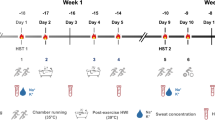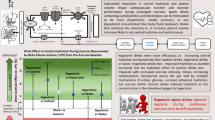Abstract
To assess the rate-limiting factor of oxygen uptake (\(\dot V{\text{O}}_{\text{2}} \)) kinetics at the onset of exercise, six healthy male sedentary subjects performed repeated one-legged constant-load cycle exercise. The one-legged constant-load exercise test consisted of two 5-min periods of pedalling at an exercise intensity of 50 W, with a 5-min rest between periods (these exercise periods, i.e. first and second exercises, were performed by the same leg). The exercise was then repeated using the other leg. In addition, two-legged incremental exercise was investigated to establish whether\(\dot V{\text{O}}_{\text{2}} \) kinetics were affected by slower heart rate kinetics. The incremental exercise test consisted of two-legged pedalling first with the cycle unloaded as a warm-up for 5 min followed by 50-W exercise for 5 min. The exercise intensity was then increased to 100 W for 5 min. During exercise, gas exchange parameters were determined by the breath-by-breath method and cardiac output (\(\dot Q_{\text{c}} \)) was determined continuously by an impedance technique with a computer-based automated system. To determine the kinetics of heart rate (HR),\(\dot Q_{\text{c}} \) and\(\dot V{\text{O}}_{\text{2}} \), a best fit procedure was employed using least-squares criteria with a time delay, except during the initial increase. During the one-legged constant-load exercise test,\(\dot V{\text{O}}_{\text{2}} \) kinetics were significantly accelerated by repeated exercise using the same leg. On the other hand, when the exercise was changed to the other leg,\(\dot V{\text{O}}_{\text{2}} \) kinetics were significantly slower, although\(\dot Q_{\text{c}} \) kinetics continued to be faster. During the incremental exercise test, although the HR response was slower at the transition from 50-W to 100-W exercise than at the transition from warm-up to 50-W exercise, there were no significant changes in\(\dot V{\text{O}}_{\text{2}} \) kinetics. These findings suggest that\(\dot V{\text{O}}_{\text{2}} \) kinetics may be affected by metabolic conditions in the muscle, but not by blood flow (\(\dot Q_{\text{c}} \) and/or HR) kinetics.
Similar content being viewed by others
References
Andzel WD, Busuttil C (1982) Metabolic and physiological response of college female to prior exercise, varied rest intervals and strenuous endurance task. J Sports Med 22:113–119
Di Prampero PF, Mahler PB, Giezendanner D, Cerretelli P (1989) Effects of priming exercise onVO2 kinetics and OZ deficit at the onset of stepping and cycling. J Appl Physiol 66:2023–2031
Forster C, Dymond DS, Carpenter J, Schmidt DH (1982) Effect of warmup on left ventricular response to sudden strenuous exercise. J Appl Physiol 53:380–383
Gausche MA, Harmon T, Lamarra N, Whipp BJ (1989) Pulmonary O2 uptake kinetics in humans are speeded by a bout of prior exercise above, but not below, the lactate threshold. Proc B Physiol Soc 142
Gutin B, Kruper J, Lewis A, Stewart K (1976) Oxygen consumption in the first stages of strenuous work as a function of prior exercise. J Sports Med 616:60–65
Hughson RL (1990) Exploring cardiorespiratory control mechanism through gas exchange dynamics. Med Sci Sports Exerc 22:72–79
Hughson RL, Morrissery M (1982) Delayed kinetics of respiratory gas exchange in the transition from prior exercise. J Appl Physiol 52:921–929
Kubicek WG, Karnegis JN, Patterson RP, Witsoe DA, Matton RH (1966) Development and evaluation of an impedance cardiac output system. Aerospace Med 37:1208–1212
Kubicek WG, Kottke FG, Ramos MU (1974) The Minnesota impedance cardiograph-theory and applications. Biomed Eng 9:410
Miyamoto Y, Takahashi M, Tamura T, Nakamura T, Hiura T, Mikami T (1981) Continuous determination of cardiac output during exercise by the use of impedance cardiography. Med Biol Eng Comput 19:638–644
Miyamoto Y, Hiura T, Tamura T, Nakamura T, Higuchi J, Mikami T (1982) Dynamics of cardiac, respiratory, and metabolic function in men in response to step work load. J Appl Physiol Respir Environ Exerc Physiol 52:1198–1208
Miyamoto Y, Higuchi J, Abe Y, Hiura T, Nakazono Y, Mikami T (1983) Dynamics of cardiac output and systolic time intervals in supine and upright exercise. J Appl Physiol Respir Environ Exerc Physiol 55:1674–1981
Muzi M, Ebert TJ, Tristani FE, Jeutter DC, Barney JA, Smith JJ (1985) Determination of cardiac output using ensemble-averaged impedance cardiograms. J Appl Physiol 58:200–205
Wasserman K, Whipp BJ, Castagna J (1974) Cardiodynamic hyperpnea: hyperpnea secondary to cardiac output increase. J Appl Physiol 36:457–464
Wasserman K, Hansen JE, Sue DY, Whipp BJ (1987) Principles of exercise testing and interpretation. Lea and Febiger, Philadelphia, pp. 27–46
Weissman ML, Jones PW, Oren A, Lamarra N, Whipp BJ, Wasserman K (1982) Cardiac output increase and gas exchange at the start of exercise. J Appl Physiol 52:236–244
Whipp BJ, Mahler M (1980) Dynamics of pulmonary gas exchange during exercise. Pulmonary gas exchange, vol.ll, Academic Press, New York, pp. 33–96
Whipp BJ, Ward S (1990) Physiological determinants of pulmonary gas exchange kinetics during exercise. Med Sci Sports Exerc 22:62–71
Whipp BJ, Ward AS, Lamarra N, Davis JA, Wasserman K (1992) Parameters of ventilatory and gas exchange dynamics during exercise. J Appl Physiol Respir Environ Exerc Physiol 52:1506–1513
Yoshida T, Watari H (1993a)31P-nuclear magnetic resonance spectroscopy study of the time course of energy metabolism during exercise and recovery. Eur J Appl Physiol 66:494–499
Yoshida T, Watari H (1993b) Metabolic consequences during repeated exercise in long distance runners. Eur J Appl Physiol 67:274–279
Yoshida T, Udo M, Ohmori T, Matsumoto Y, Uramoto T, Yamamoto K (1992) Day-to-day changes in oxygen uptake kinetics at the onset of exercise during strenuous endurance training. Eur J Appl Physiol 64:78–83
Yoshida T, Yamamoto K, Udo M (1993) Relationship between cardiac output and oxygen uptake at the onset of exercise. Eur J Appl Physiol 66:155–160
Author information
Authors and Affiliations
Rights and permissions
About this article
Cite this article
Yoshida, T., Kamiya, J. & Hishimoto, K. Are oxygen uptake kinetics at the onset of exercise speeded up by local metabolic status in active muscles?. Europ. J. Appl. Physiol. 70, 482–486 (1995). https://doi.org/10.1007/BF00634376
Accepted:
Issue Date:
DOI: https://doi.org/10.1007/BF00634376




